NATO Forces -Overview- WWIII Team Yankee
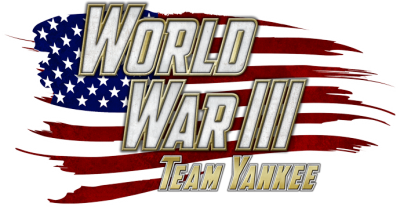
By Matty MacKenzie
It’s the dawn of a new era in warfare, weapon development, tactics, and clandestine operations are all the rage in the 1980’s. The Cold War is in full swing, the Russians have pushed into Europe.
Their first step is moving deeper into Europe via Eastern Germany. Encountering heavy resistance and Canadian forces, who are ready to push back against the onslaught of T-72 tanks, this is where the new NATO book from Battlefront’s Team Yankee picks up.
The book opens with a nicely laid-out index, that I believe has gotten better over the years and through the course of several games produced by Battlefront. Team Yankee NATO Forces gives each country an equal shake in this publication.
What you will find inside is a little over 150 pages of NATO formations from Canada, France, Netherlands, ANZAC forces, and finally, Belgians. Each one of them receives about thirty pages apiece for you to go through and pick from should you wish to field formations from the new NATO countries available.

The narratives that are presented in this book are well written, including some very nice battle overviews, complete with troop movements, unit composition, and realistic timelines. War in the 1980’s was a slow and deliberate business. Much as we see nearly forty years later playing out in the current climate of Eastern Europe.
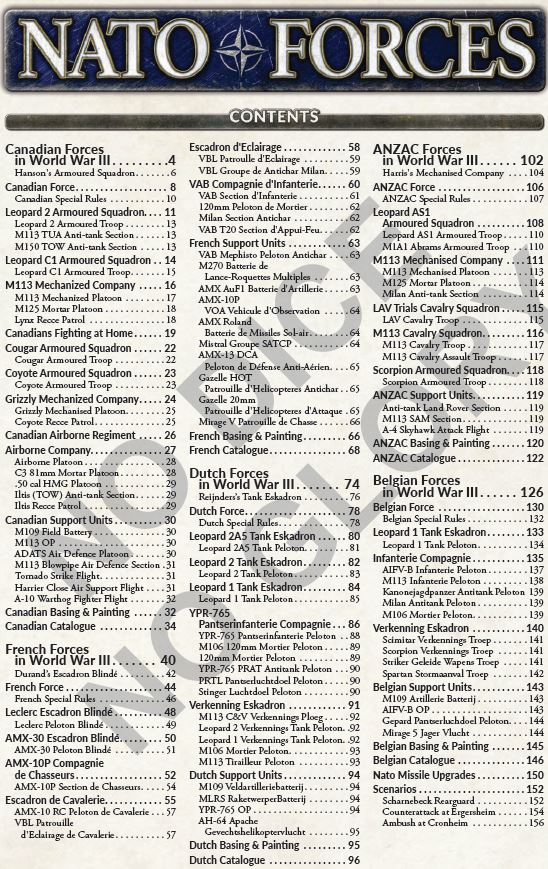
Nothing happens overnight that can not be rewritten the very next day. Supply, sustainment, and reconstitution of forces, all of this has an effect on the battlefield. NATO was created from the ashes of WW2 and was a way to strategically protect Europe, its allies, and partners in order to inject stability and peace of mind to those that lived there.
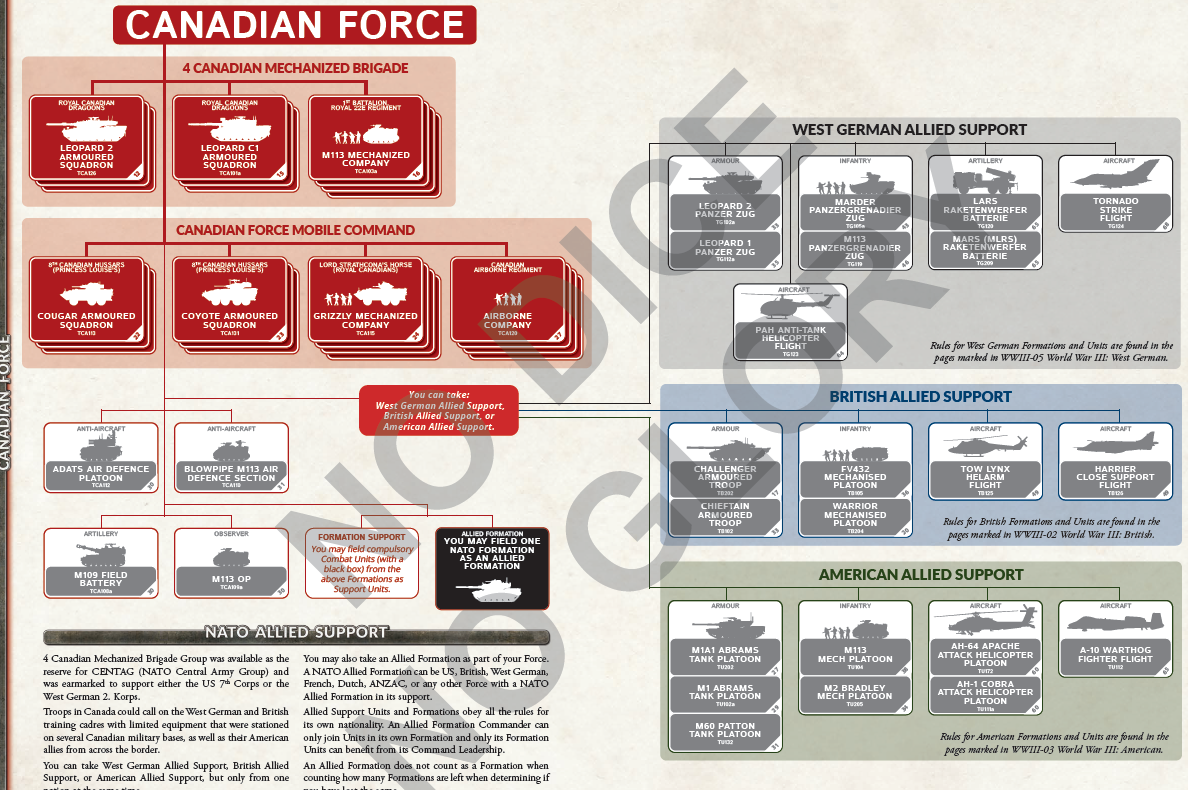
When the Russians moved on Europe and then a carefully orchestrated attack on North America, NATO Forces were caught off guard. This type of attack was likely a result of the removal of intermediate missiles in Europe and Russia. General Rogers, who commanded all NATO forces during that time, protested this move by the Reagan administration as reckless due to the overwhelming number of Soviet ground forces versus the slightly smaller numbers that NATO could respond with at the time.
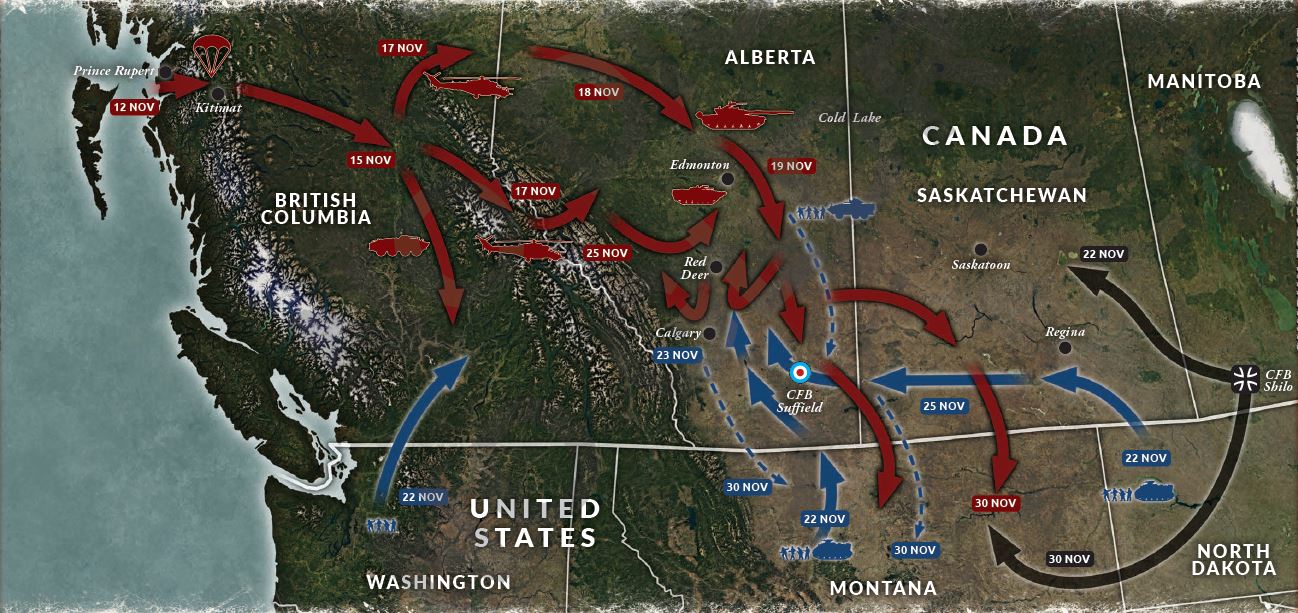
Canada can respond with several different options in NATO Forces, you have a couple of tank-centric formations with the Leopard 2 leading the charge. Recce and mechanized formations and smaller unit options give you some flexibility in rounding out a competitive list. The Canadian Airborne Regiment was also a big part of the Canadian Armed Forces in the 1980s and early 90s. Specialized troops with a myriad of skills, Huey helicopters, Iltis (jeep type vehicles) and weapon platoons using .50 CAL, TOW assets for a decent amount of firepower.
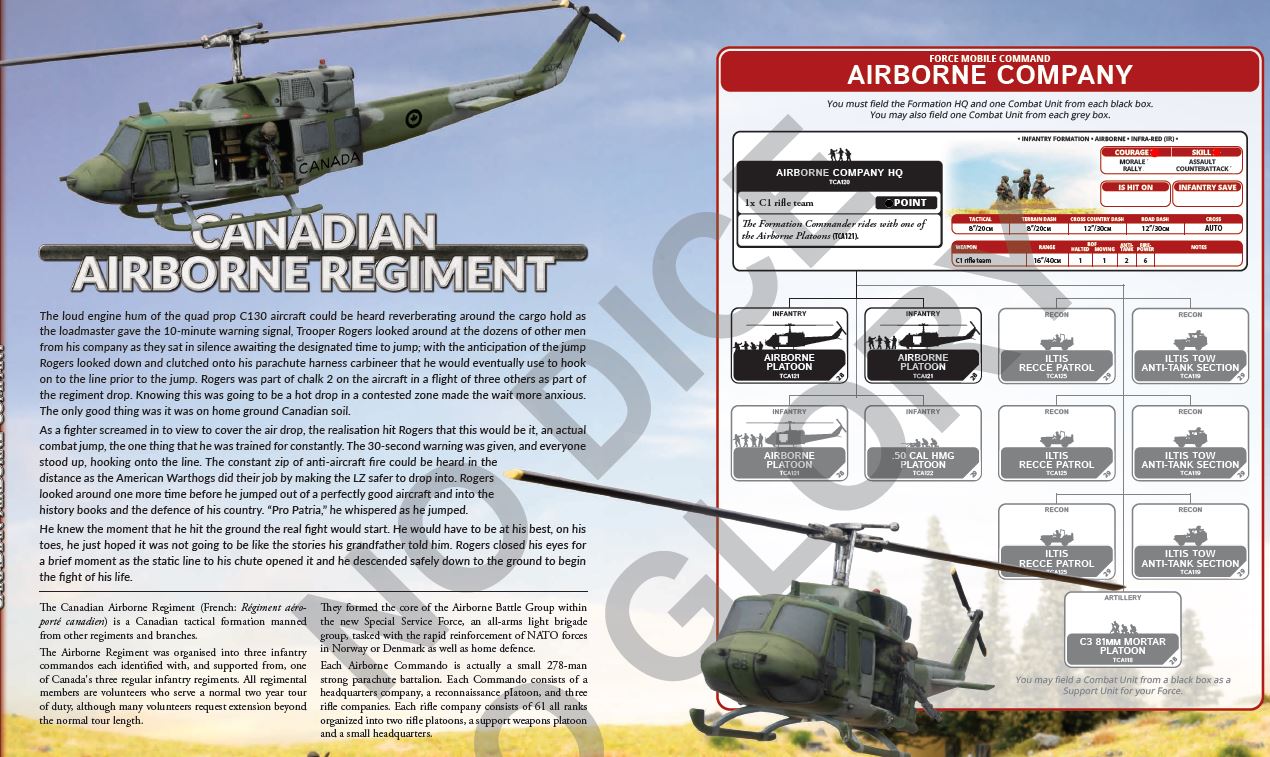
The Canadian Airborne Regiment formation is going to be popular for sure, during the Cold War it would have been a near elite fighting force.

Not wanting to repeat the mistakes of the past, France has a big part to play in NATO. Protecting their European neighbors not only brings more forces to a NATO response but also gives Paris the peace of mind that there is finally a buffer between them and any aggressor that takes any issue with the French. NATO Forces brings in Leclerc tank and AMX-10 formations, the one thing that is definitely noticeable in the new book is the proper use of the French words for all of their formations, units, and vehicles.

Time to brush up on your French pronunciations and Battlefront has made it a little easier by including the words broken down in parenthesis beside each in this section. AMX self-propelled artillery and the M270 Batterie De Lanc-Roquettes Multiples simply breaks down and translates to M270 Multiple Rocket Launcher Battery. (A note from Matty: Being one of the few Canadian staffers here at No Dice, I can fumble my way through.)
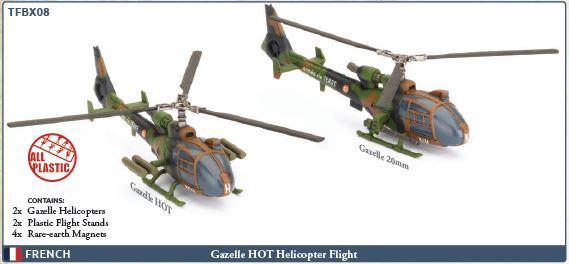
The Royal Netherlands Army contribution into the NATO Forces book should not be taken lightly. One of the founding members of NATO, they finally started deploying their forces in West Germany. This gave them a better response time in the case of Russian attacks and provided some of their allies with a little more confidence that the Dutch were truly able to respond in time of crisis. Had they left all of their forces within the border of their own country, getting to the forward edge of a NATO lead response would have been much slower.
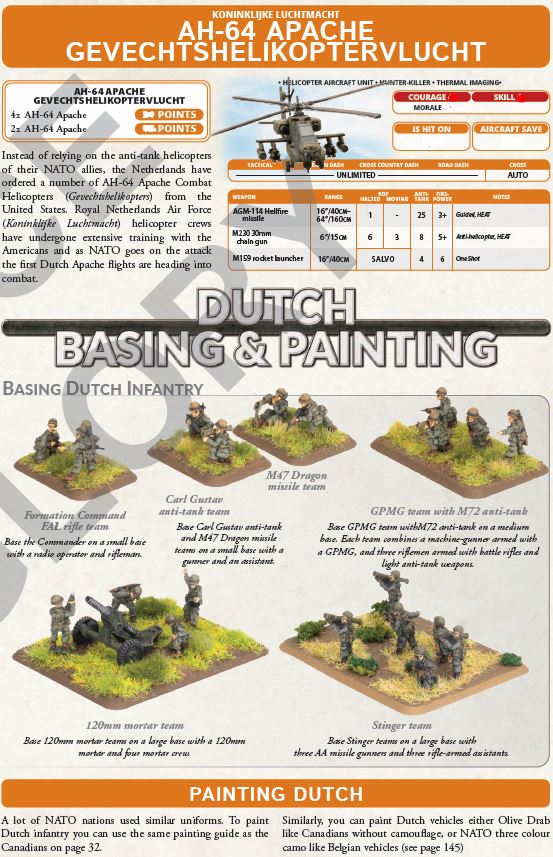
Basing and painting guide for the Dutch forces are pretty straight forward. US Apache support options for the Netherlands is going to be ‘uge!!
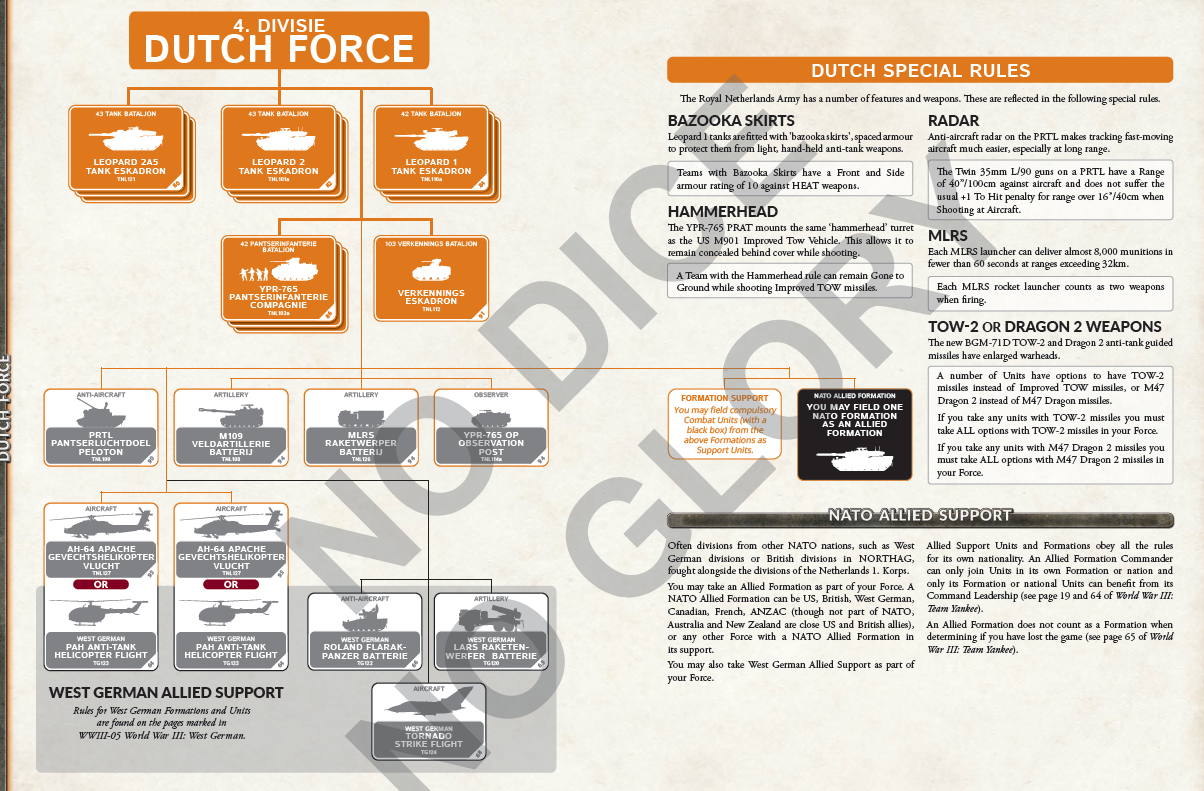
How good is it to be one of the oldest militaries in history, be a NATO founding member, and then in NATO Forces, have access to a massive support system for list building? American Apache helicopters, West German PAH Anti-Tank assets, Tornado strike aircraft. All of these play a potential spoiler to any Russian opponent you might encounter in the Team Yankee battlespace, rounding out support from the West Germans is the ever-impressive Gepard Flak Battery.
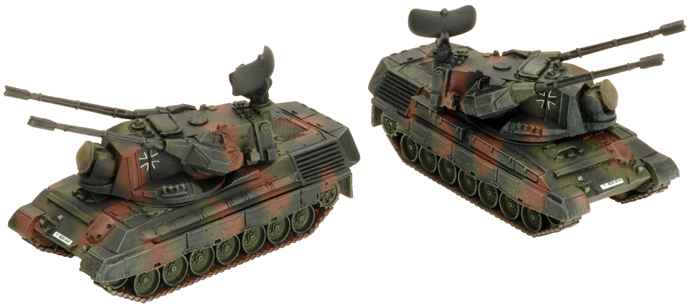
The last two options in the NATO Forces book are Belgium and ANZAC, with the latter providing help to launch a counterattack into the Netherlands after a successful Russian push into the Dutch nation. Australian and New Zealand ANZAC formations can be bolstered with British Allied Support options, in some cases, you can field a single NATO Formation as an Allied Formation. Certainly rounding out your lists and giving you a few options, as they are a smaller force construct coming from the two island nations. I think the Anti-Tank Land Rover Section is one of my favorites from this new book.
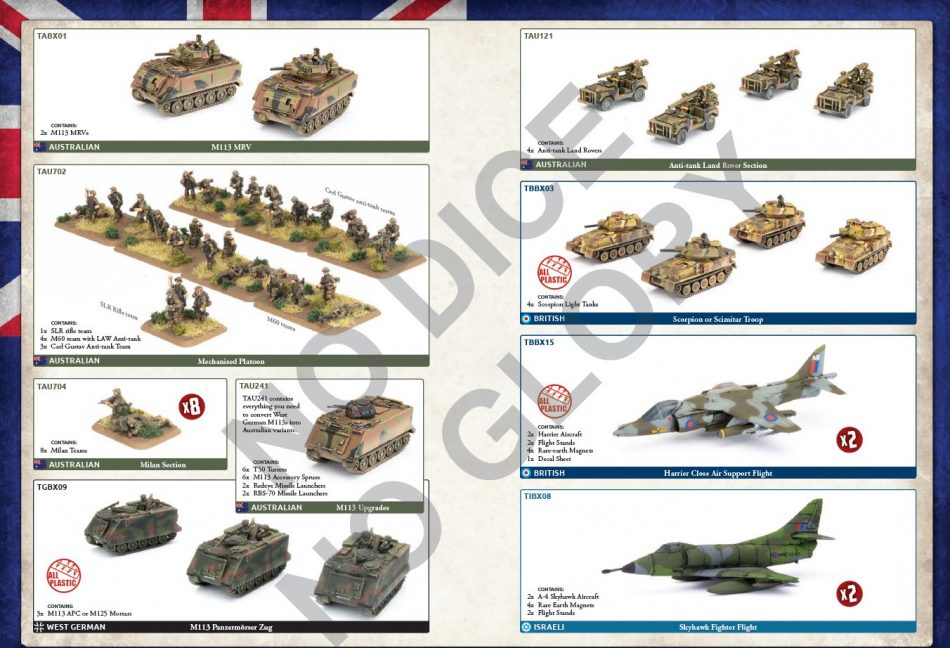
Along with the US, W. German and British choices, Aussies and Kiwis bring their own kit to the fight!

Considered an ‘Unarmored Tank Unit’ and ‘Scout’, the Anti-Tank Land Rover Section has either a 4x or 2x unit option, the 106mm recoilless rifle deals an impressive AT 17 with a 2+ FP
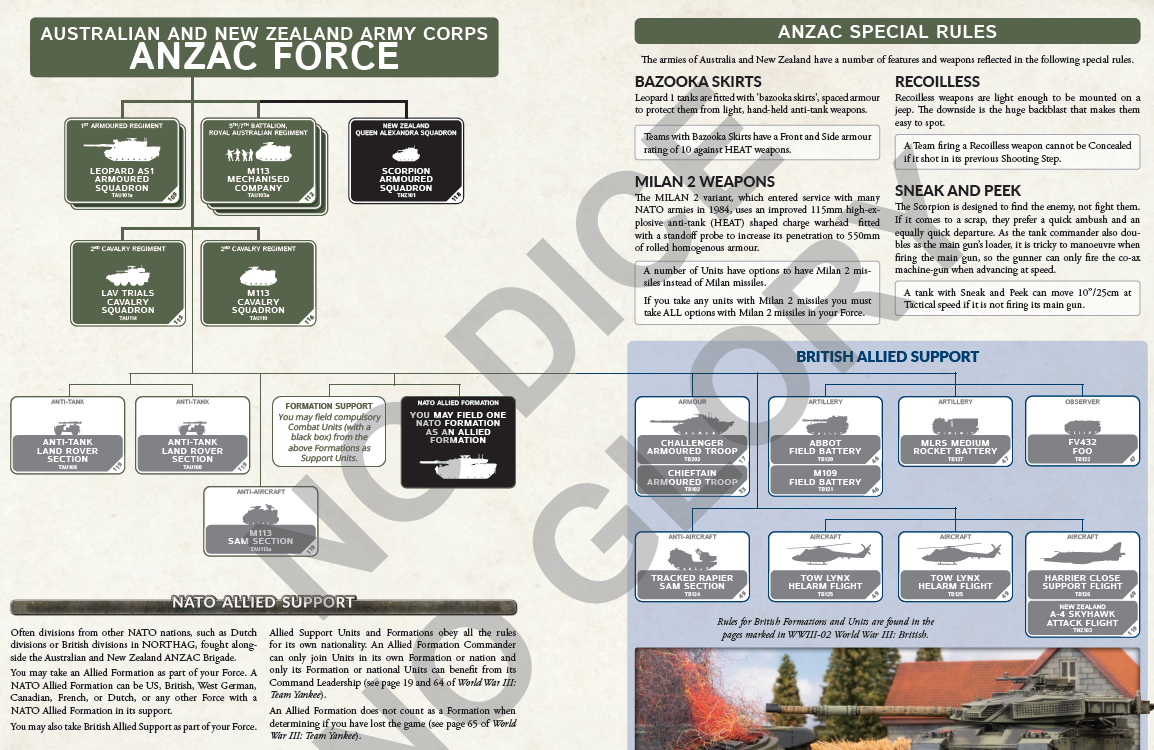
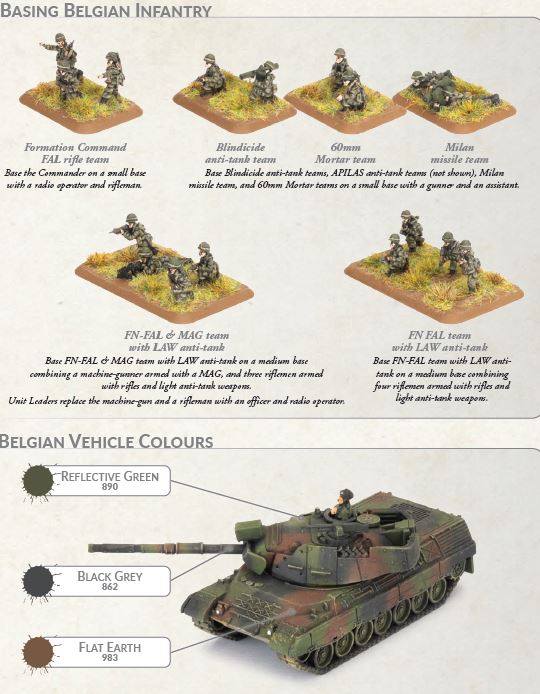
Within the NATO Forces book, you will find painting guides, color choices, and a brief explanation of how to properly base your figures to create personalized forces. The 1980 camo schemes for most NATO countries followed a very basic application of greens, browns, and black in order to break up and blend in with the terrain found in most of Europe.

Belgium, although a smaller country in land mass, packed a pretty big punch and the formation choices reflect it in the new book. I’m excited to see them included as they are able to field Mirage 5 fighter-bombers, M-109 Self-Propelled Artillery, fairly cost-effective Infantry options, and of course Leopard 1 tanks. Look to them for something different and like the other formations, a blend of special rules and the ability to take Allied support options, will bolster any Belgian force you like.

Still one of the best-looking models in the game, the British Lynx HELARM Helicopter flight can be added to your Belgium list, just follow the list formation guidelines found in the NATO Forces book and I think we will see them get played quite often as there are a lot of players that will have many German, British and American units they can add.

Some new missile rules for all NATO nations are included in the new book!
Look for a breakdown of each of the countries briefly outlined in my quick overview of the NATO Forces book for the Team Yankee WWIII gaming system from Battlefront. It was really hard not to spoil all of the forces in this book. The back of the book itself also has scenarios listed in it, a total of three scenario options to give you something different to play through.

You can either use the pre-made lists provided and go through the scenario as described, or you have the option to create your own lists using the points totals provided. It will be interesting to see these in person during a game. It breaks up the regular scenario modes found in the main rules and they seem to be pretty challenging the way they are presented. Stay in touch with us here at No Dice No Glory for all of the latest updates and breakdowns of this upcoming book. Look for it October 7th 2023

So have BF once again not given mixed recce plts of Scimitar/Scorpion , to the Belgian 1ste Jaagers te Paard and 4e Chasseurs a Cheval ?
Belgian M106 , from everything i’ve seen they used truck-towed 4.2” mortars at the time .
Belgian Leo 1 BE never had extra armour on the turrets .
Hopefull the Belgian AIFV plts are a mix of 2 with 25mm in a turret and 2 with a 12.7mm mounted on the commanders cupola .
Seems they got the mech inf transport wrong , should be 2 with 25mm in a turret and 2 with a 12.7mm , unless a reserve unit which would have all M113 . Not 4 x AIFV with 25mm , or 4 AIFV 12.7 mm per plt .
I believe so far you are looking at 25mm with an option for Milan upgrades.
Shame about the 4.2 mortars, maybe this is about already having a steady supply of M109?
The M113A1-B-MIL was the dedicated tank destroyer at the time , they were in Anti-tank Companies of regular Brigades . Later they used the AIFV-B-MIL .
As for the 4.2 mortars , its the same model as used in the NAM range .
Awesome, its a shame the ILTIS don’t have a special rule where they tip over if they fail a bog check 🙂
Rolling was not much of an issue in these ‘tubs’. I loved these little vehicles, transverse mounted springs for suspension and a very dependable Volkswagen engine that was not unlike the one in my Golf GL. Having worked on these just before they were completely phased out, they certainly only looked good in two configurations. TOW in the back and the MP variant with lights.
..a what? A bog check? That’s only in the first version of Team Yankee? Or am I wrong? We only have Cross checks now, right?
Would be funny to see ‘tho, specific quirks for vehicles and such.
Weird that LdSH(RC) are the Canadian Grizzly company.
LdSH is an armoured unit
No Canadian armour unit ever used Grizzlies to my knowledge. Grizzlies are an infantry carrier variant of the AVGP. They should be PPCLI for the western Canada theme or RCR/R22R otherwise.
You would know with your background! I think mechanized infantry only? Maybe they confused it with another line out of the AVGP family?
Here is a photo showing 9A in the VIII CH using a Grizzly. http://anzacsteel.hobbyvista.com/Armoured%20Vehicles/anniversarydayph_1.htm